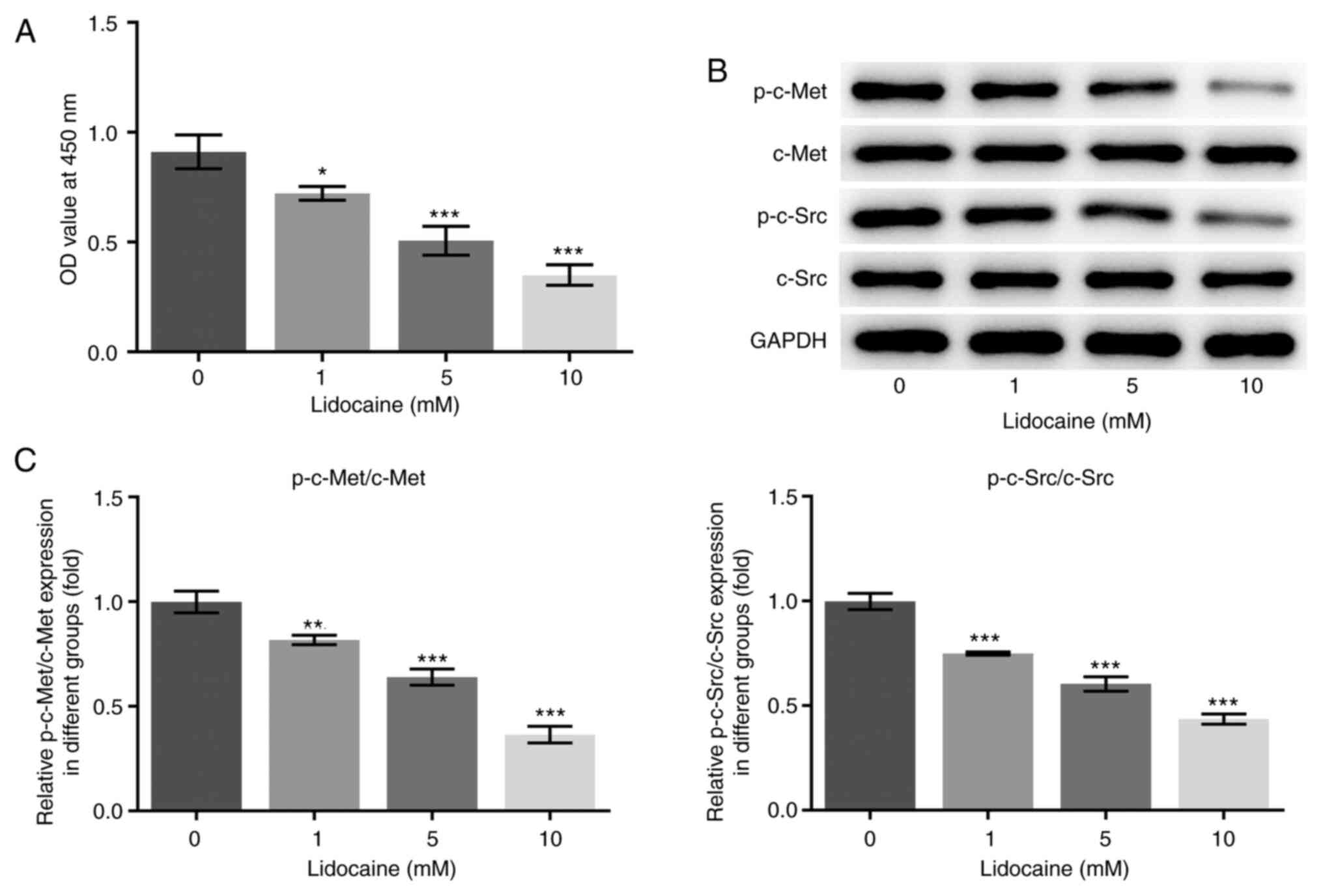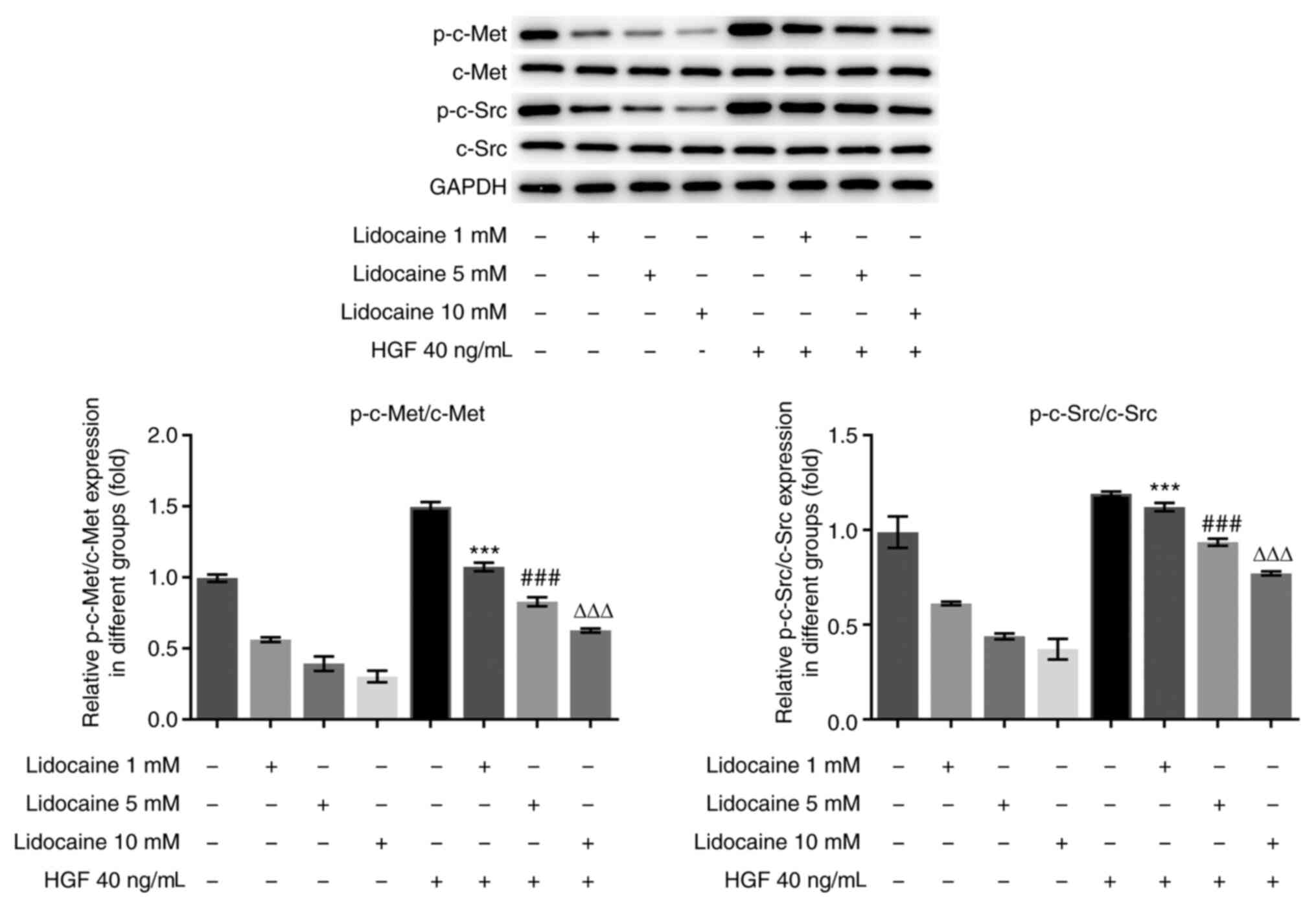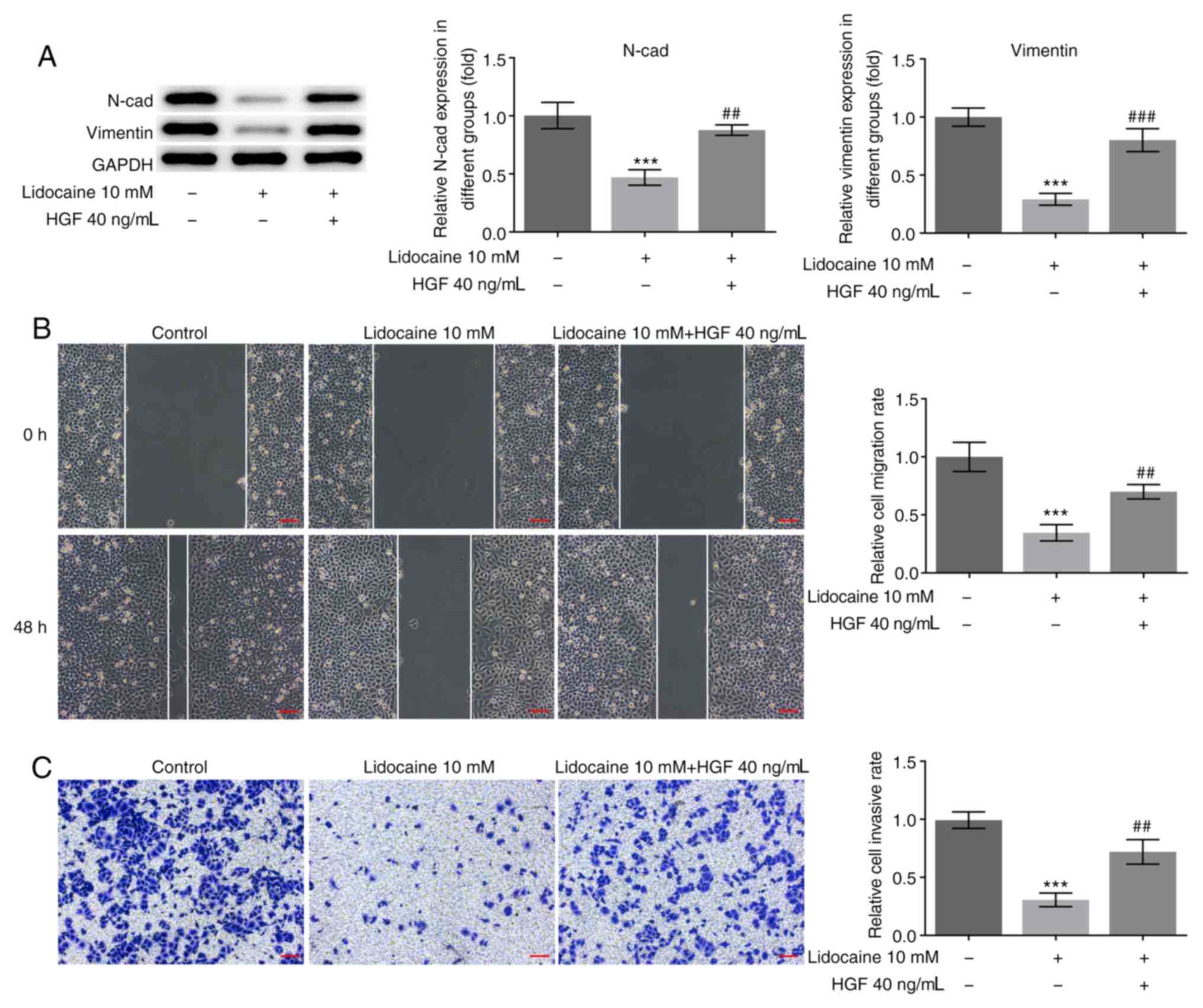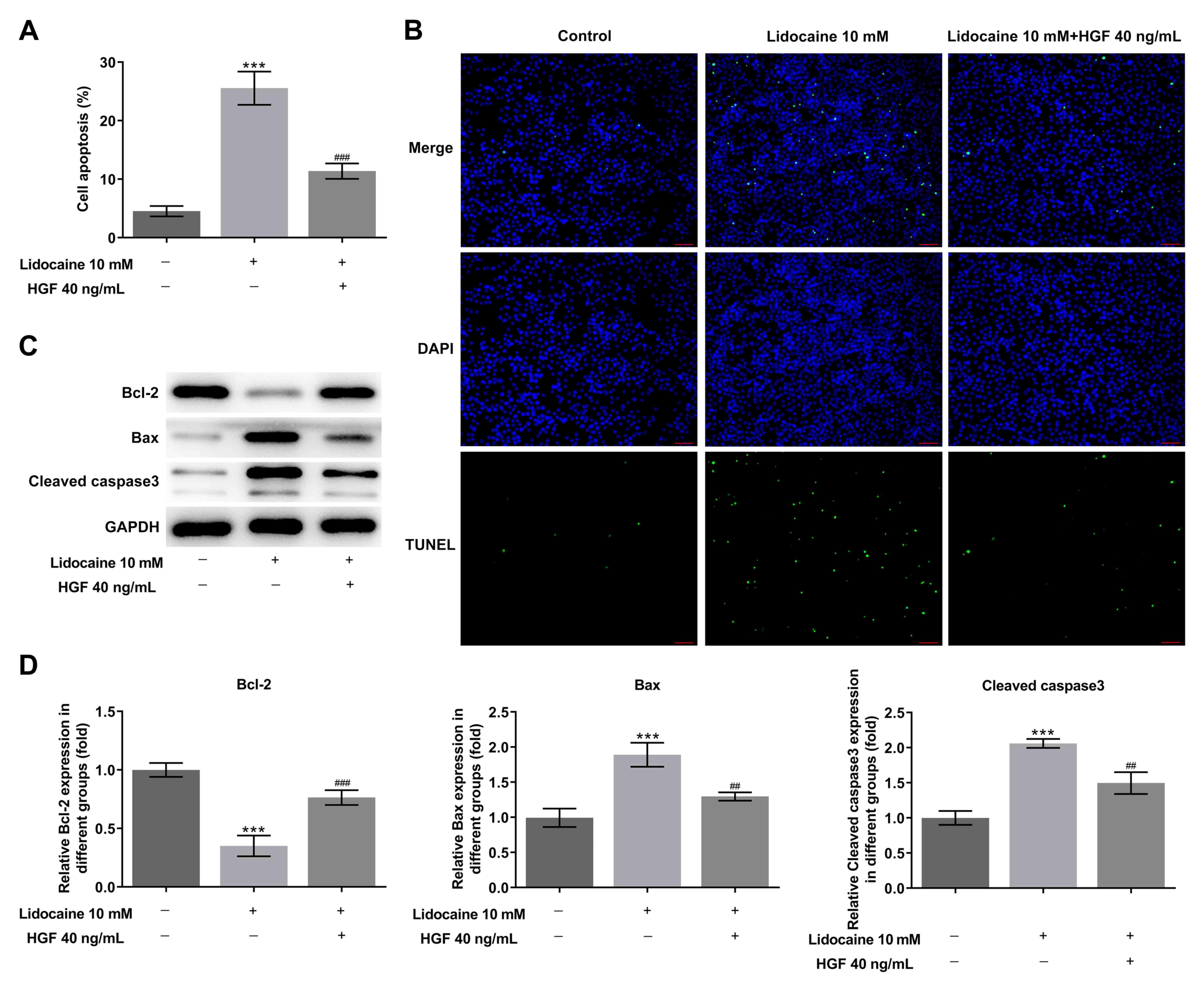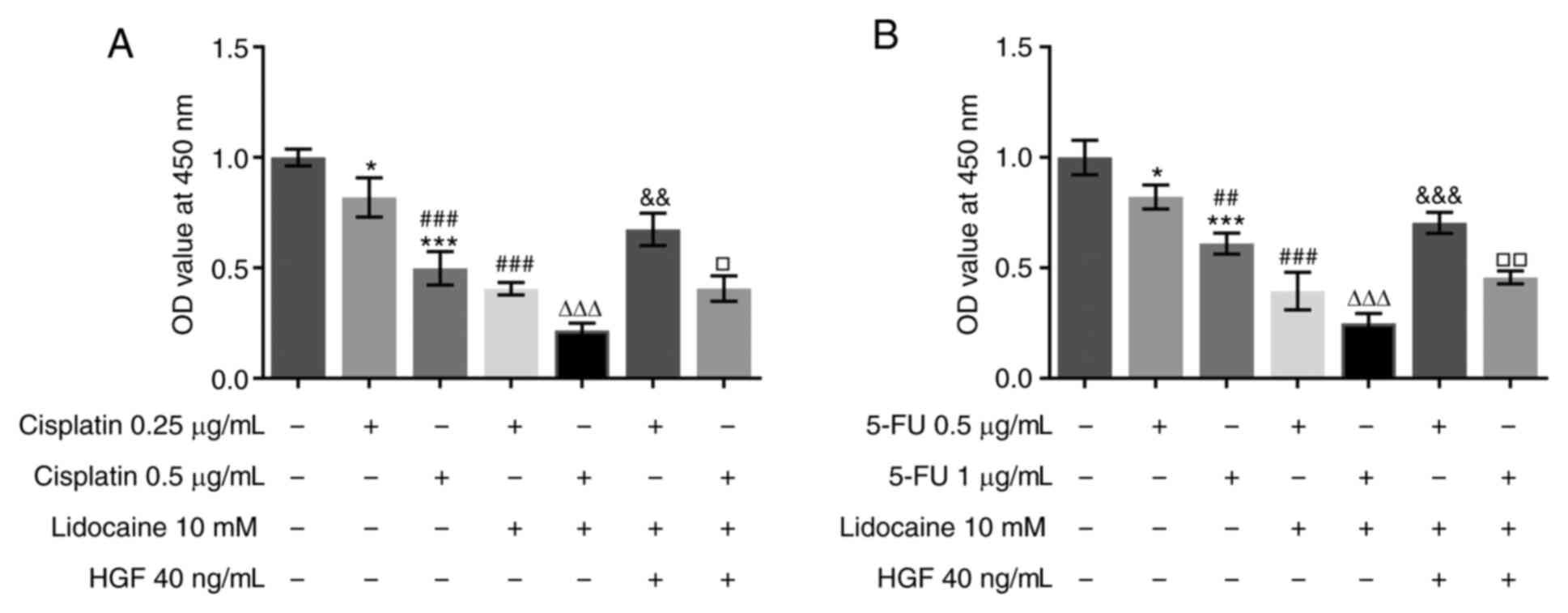|
1
|
Ferlay J, Soerjomataram I, Dikshit R, Eser
S, Mathers C, Rebelo M, Parkin DM, Forman D and Bray F: Cancer
incidence and mortality worldwide: Sources, methods and major
patterns in GLOBOCAN 2012. Int J Cancer. 136:E359–E386.
2015.PubMed/NCBI View Article : Google Scholar
|
|
2
|
Casamayor M, Morlock R, Maeda H and Ajani
J: . Targeted literature review of the global burden of gastric
cancer. Ecancermedicalscience. 12(883)2018.PubMed/NCBI View Article : Google Scholar
|
|
3
|
Sui H, Lou A, Li Z and Yang J: . Lidocaine
inhibits growth, migration and invasion of gastric carcinoma cells
by up-regulation of miR-145. BMC Cancer. 19(233)2019.PubMed/NCBI View Article : Google Scholar
|
|
4
|
Yang W, Cai J, Zhang H, Wang G and Jiang
W: . Effects of lidocaine and ropivacaine on gastric cancer cells
through down-regulation of ERK1/2 phosphorylation in vitro.
Anticancer Res. 38:6729–6735. 2018.PubMed/NCBI View Article : Google Scholar
|
|
5
|
Ye L, Zhang Y, Chen YJ and Liu Q:
Anti-tumor effects of lidocaine on human gastric cancer cells in
vitro. Bratisl Lek Listy. 120:212–217. 2019.PubMed/NCBI View Article : Google Scholar
|
|
6
|
Piegeler T, Votta-Velis EG, Bakhshi FR,
Mao M, Carnegie G, Bonini MG, Schwartz DE, Borgeat A, Beck-Schimmer
B and Minshall RD: Endothelial barrier protection by local
anesthetics: Ropivacaine and lidocaine block tumor necrosis
factor-α-induced endothelial cell src activation. Anesthesiology.
120:1414–1428. 2014.PubMed/NCBI View Article : Google Scholar
|
|
7
|
Piegeler T, Votta-Velis EG, Liu G, Place
AT, Schwartz DE, Beck-Schimmer B, Minshall RD and Borgeat A:
Antimetastatic potential of amide-linked local anesthetics:
Inhibition of lung adenocarcinoma cell migration and inflammatory
src signaling independent of sodium channel blockade.
Anesthesiology. 117:548–559. 2012.PubMed/NCBI View Article : Google Scholar
|
|
8
|
Wall TP, Crowley PD, Sherwin A, Foley AG
and Buggy DJ: Effects of lidocaine and src inhibition on metastasis
in a murine model of breast cancer surgery. Cancers (Basel).
11(1414)2019.PubMed/NCBI View Article : Google Scholar
|
|
9
|
Matsumoto K, Umitsu M, De Silva DM, Roy A
and Bottaro DP: Hepatocyte growth factor/MET in cancer progression
and biomarker discovery. Cancer Sci. 108:296–307. 2017.PubMed/NCBI View Article : Google Scholar
|
|
10
|
Han SU, Lee HY, Lee JH, Kim WH, Nam H, Kim
H, Cho YK, Kim MW and Lee KU: Modulation of E-cadherin by
hepatocyte growth factor induces aggressiveness of gastric
carcinoma. Ann Surg. 242:676–683. 2005.PubMed/NCBI View Article : Google Scholar
|
|
11
|
Lee KH, Choi EY, Hyun MS, Jang BI, Kim TN,
Kim SW, Song SK, Kim JH and Kim JR: Hepatocyte growth factor/c-met
signaling in regulating urokinase plasminogen activator in human
stomach cancer: A potential therapeutic target for human stomach
cancer. Korean J Intern Med. 21:20–27. 2006.PubMed/NCBI View Article : Google Scholar
|
|
12
|
Park WS, Oh RR, Kim YS, Park JY, Shin MS,
Lee HK, Lee SH, Yoo NJ and Lee JY: Absence of mutations in the
kinase domain of the met gene and frequent expression of met and
HGF/SF protein in primary gastric carcinomas. APMIS. 108:195–200.
2000.PubMed/NCBI View Article : Google Scholar
|
|
13
|
Okamoto W, Okamoto I, Yoshida T, Okamoto
K, Takezawa K, Hatashita E, Yamada Y, Kuwata K, Arao T, Yanagihara
K, et al: Identification of c-src as a potential therapeutic target
for gastric cancer and of MET activation as a cause of resistance
to c-src inhibition. Mol Cancer Ther. 9:1188–1197. 2010.PubMed/NCBI View Article : Google Scholar
|
|
14
|
Kuniyasu H, Yasui W, Kitadai Y, Yokozaki
H, Ito H and Tahara E: Frequent amplification of the c-met gene in
scirrhous type stomach cancer. Biochem Biophys Res Commun.
189:227–232. 1992.PubMed/NCBI View Article : Google Scholar
|
|
15
|
Nessling M, Solinas-Toldo S, Wilgenbus KK,
Borchard F and Lichter P: Mapping of chromosomal imbalances in
gastric adenocarcinoma revealed amplified protooncogenes MYCN, MET,
WNT2, and ERBB2. Genes Chromosomes Cancer. 23:307–316.
1998.PubMed/NCBI View Article : Google Scholar
|
|
16
|
Sakakura C, Mori T, Sakabe T, Ariyama Y,
Shinomiya T, Date K, Hagiwara A, Yamaguchi T, Takahashi T, Nakamura
Y, et al: Gains, losses, and amplifications of genomic materials in
primary gastric cancers analyzed by comparative genomic
hybridization. Genes Chromosomes Cancer. 24:299–305.
1999.PubMed/NCBI View Article : Google Scholar
|
|
17
|
Irby RB and Yeatman TJ: Role of src
expression and activation in human cancer. Oncogene. 19:5636–5642.
2000.PubMed/NCBI View Article : Google Scholar
|
|
18
|
Kim LC, Song L and Haura EB: Src kinases
as therapeutic targets for cancer. Nat Rev Clin Oncol. 6:587–595.
2009.PubMed/NCBI View Article : Google Scholar
|
|
19
|
Anestis A, Zoi I and Karamouzis MV:
Current advances of targeting HGF/c-Met pathway in gastric cancer.
Ann Transl Med. 6(247)2018.PubMed/NCBI View Article : Google Scholar
|
|
20
|
Moosavi F, Giovannetti E, Saso L and
Firuzi O: HGF/MET pathway aberrations as diagnostic, prognostic,
and predictive biomarkers in human cancers. Crit Rev Clin Lab Sci.
56:533–566. 2019.PubMed/NCBI View Article : Google Scholar
|
|
21
|
Summy JM and Gallick GE: Src family
kinases in tumor progression and metastasis. Cancer Metastasis Rev.
22:337–358. 2003.PubMed/NCBI View Article : Google Scholar
|
|
22
|
Yan H, Sun Y, Wu Q, Wu Z, Hu M, Sun Y, Liu
Y, Ma Z, Liu S, Xiao W, et al: PELP1 suppression inhibits gastric
cancer through downregulation of c-Src-PI3K-ERK pathway. Front
Oncol. 9(1423)2019.PubMed/NCBI View Article : Google Scholar
|
|
23
|
Kim HJ, Kang SK, Kwon WS, Kim TS, Jeong I,
Jeung HC, Kragh M, Horak ID, Chung HC and Rha SY: Forty-nine
gastric cancer cell lines with integrative genomic profiling for
development of c-MET inhibitor. Int J Cancer. 143:151–159.
2018.PubMed/NCBI View Article : Google Scholar
|
|
24
|
Huang KH, Sung IC, Fang WL, Chi CW, Yeh
TS, Lee HC, Yin PH, Li AF, Wu CW, Shyr YM and Yang MH: Correlation
between HGF/c-Met and notch1 signaling pathways in human gastric
cancer cells. Oncol Rep. 40:294–302. 2018.PubMed/NCBI View Article : Google Scholar
|
|
25
|
Oh HA, Lee G, Kang HJ, Kim YG, Bae SH, Lee
JL, Lee KH, Hyun MS and Kim DS: Overexpression of c-met protein in
gastric cancer and role of uPAR as a therapeutic target. Cancer Res
Treat. 35:9–15. 2003.PubMed/NCBI View Article : Google Scholar
|
|
26
|
Chen C, Tang X, Liu Y, Zhu J and Liu J:
Induction/reversal of drug resistance in gastric cancer by
non-coding RNAs (Review). Int J Oncol. 54:1511–1524.
2019.PubMed/NCBI View Article : Google Scholar
|
|
27
|
Kiriyama S, Oda I, Nishimoto F, Mashimo Y,
Ikehara H and Gotoda T: Pilot study to assess the safety of local
lidocaine injections during endoscopic submucosal dissection for
early gastric cancer. Gastric Cancer. 12:142–147. 2009.PubMed/NCBI View Article : Google Scholar
|
|
28
|
Kim TH, Kang H, Choi YS, Park JM, Chi KC,
Shin HY and Hong JH: Pre- and intraoperative lidocaine injection
for preemptive analgesics in laparoscopic gastrectomy: A
prospective, randomized, double-blind, placebo-controlled study. J
Laparoendosc Adv Surg Tech A. 23:663–668. 2013.PubMed/NCBI View Article : Google Scholar
|
|
29
|
Yao L, Zhang D, Zhao X, Sun B, Liu Y, Gu
Q, Zhang Y, Zhao X, Che N, Zheng Y, et al: Dickkopf-1-Promoted
vasculogenic mimicry in non-small cell lung cancer is associated
with EMT and development of a cancer stem-like cell phenotype. J
Cell Mol Med. 20:1673–1685. 2016.PubMed/NCBI View Article : Google Scholar
|
|
30
|
Acloque H, Adams MS, Fishwick K,
Bronner-Fraser M and Nieto MA: Epithelial-mesenchymal transitions:
The importance of changing cell state in development and disease. J
Clin Invest. 119:1438–1449. 2009.PubMed/NCBI View
Article : Google Scholar
|
|
31
|
Toiyama Y, Yasuda H, Saigusa S, Matushita
K, Fujikawa H, Tanaka K, Mohri Y, Inoue Y, Goel A and Kusunoki M:
Co-Expression of hepatocyte growth factor and c-met predicts
peritoneal dissemination established by autocrine hepatocyte growth
factor/c-met signaling in gastric cancer. Int J Cancer.
130:2912–2921. 2012.PubMed/NCBI View Article : Google Scholar
|
|
32
|
Lee JC, Koh SA, Lee KH and Kim JR: BAG3
contributes to HGF-mediated cell proliferation, migration, and
invasion via the egr1 pathway in gastric cancer. Tumori. 105:63–75.
2019.PubMed/NCBI View Article : Google Scholar
|
|
33
|
Koh SA and Lee KH: HGF-Mediated S100A11
overexpression enhances proliferation and invasion of gastric
cancer. Am J Transl Res. 10:3385–3394. 2018.PubMed/NCBI
|
|
34
|
Konturek PC, Konturek SJ, Sulekova Z,
Meixner H, Bielanski W, Starzynska T, Karczewska E, Marlicz K,
Stachura J and Hahn EG: Expression of hepatocyte growth factor,
transforming growth factor alpha, apoptosis related proteins bax
and bcl-2, and gastrin in human gastric cancer. Aliment Pharmacol
Ther. 15:989–999. 2001.PubMed/NCBI View Article : Google Scholar
|
|
35
|
Kamiya Y, Ohta K and Kaneko Y:
Lidocaine-induced apoptosis and necrosis in U937 cells depending on
its dosage. Biomed Res. 26:231–239. 2005.PubMed/NCBI View Article : Google Scholar
|
|
36
|
Qu X, Yang L, Shi Q, Wang X, Wang D and Wu
G: Lidocaine inhibits proliferation and induces apoptosis in
colorectal cancer cells by upregulating mir-520a-3p and targeting
EGFR. Pathol Res Pract. 214:1974–1979. 2018.PubMed/NCBI View Article : Google Scholar
|
|
37
|
Zhu J and Han S: Lidocaine inhibits
cervical cancer cell proliferation and induces cell apoptosis by
modulating the lncRNA-MEG3/miR-421/BTG1 pathway. Am J Transl Res.
11:5404–5416. 2019.PubMed/NCBI
|
|
38
|
Arnold L, Enders J and Thomas SM:
Activated HGF-c-met axis in head and neck cancer. Cancers (Basel).
9(169)2017.PubMed/NCBI View Article : Google Scholar
|
|
39
|
Rucki AA, Xiao Q, Muth S, Chen J, Che X,
Kleponis J, Sharma R, Anders RA, Jaffee EM and Zheng L: Dual
inhibition of hedgehog and c-met pathways for pancreatic cancer
treatment. Mol Cancer Ther. 16:2399–2409. 2017.PubMed/NCBI View Article : Google Scholar
|
|
40
|
Leonetti E, Gesualdi L, Scheri KC,
Dinicola S, Fattore L, Masiello MG, Cucina A, Mancini R, Bizzarri
M, Ricci G and Catizone A: C-Src recruitment is involved in
c-MET-mediated malignant behaviour of NT2D1 non-seminoma cells. Int
J Mol Sci. 20(320)2019.PubMed/NCBI View Article : Google Scholar
|















